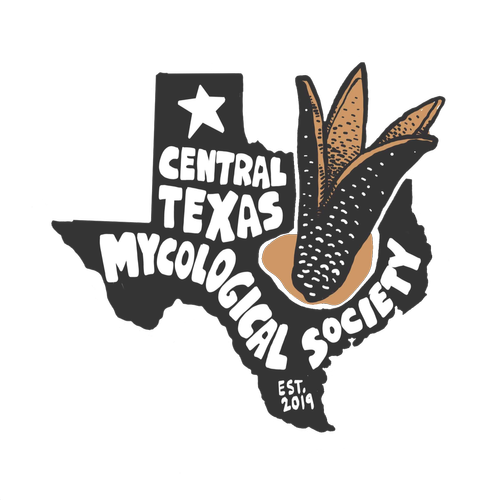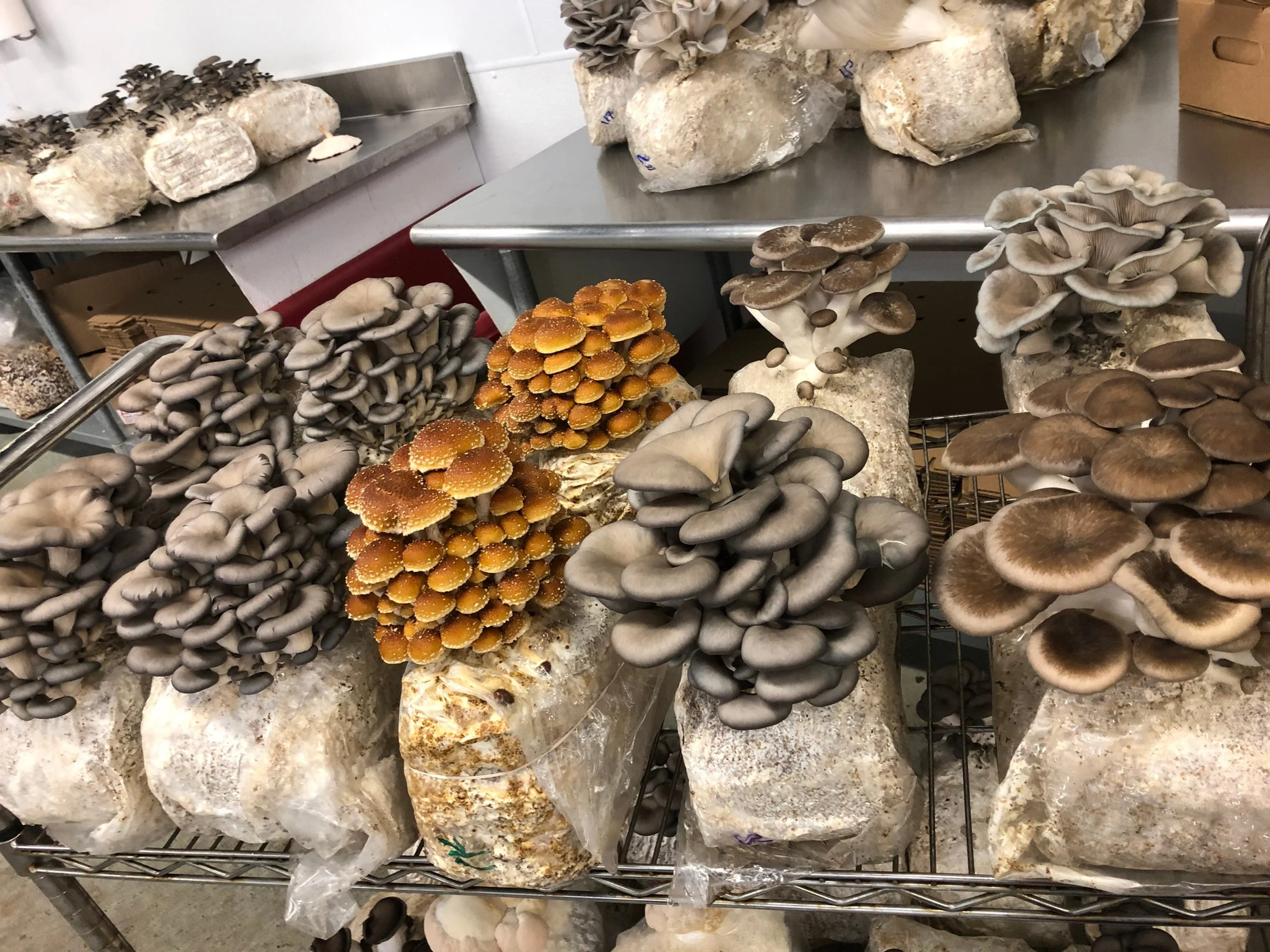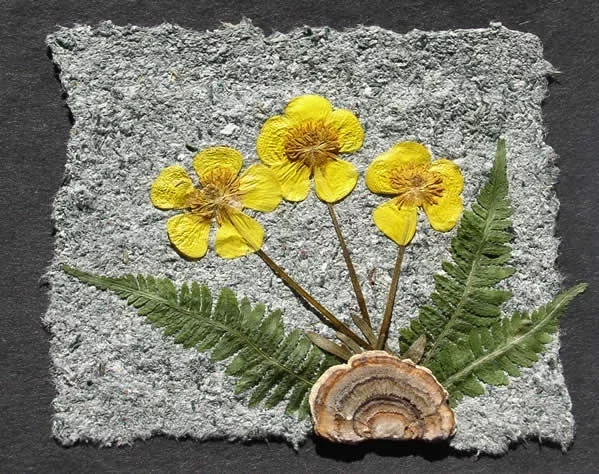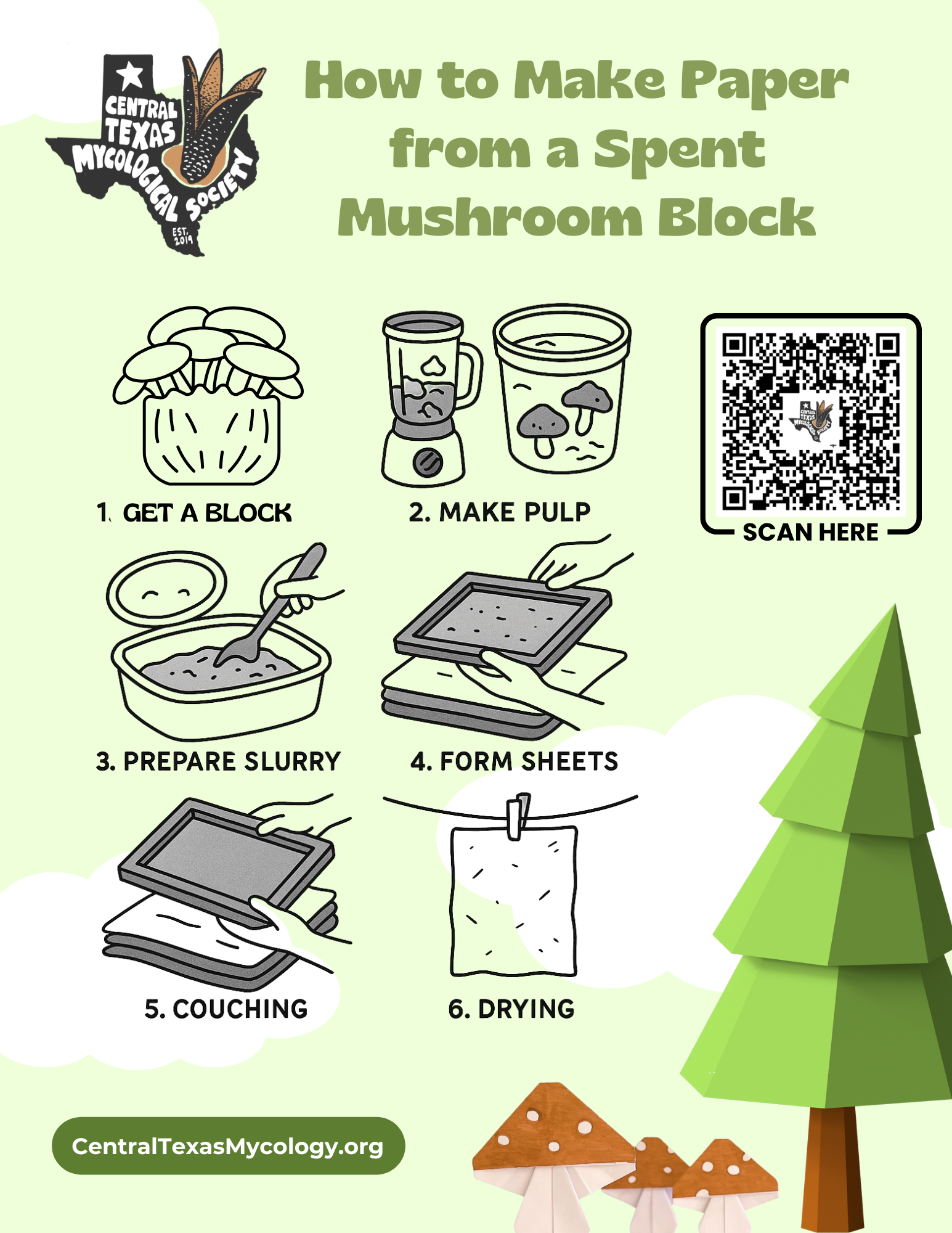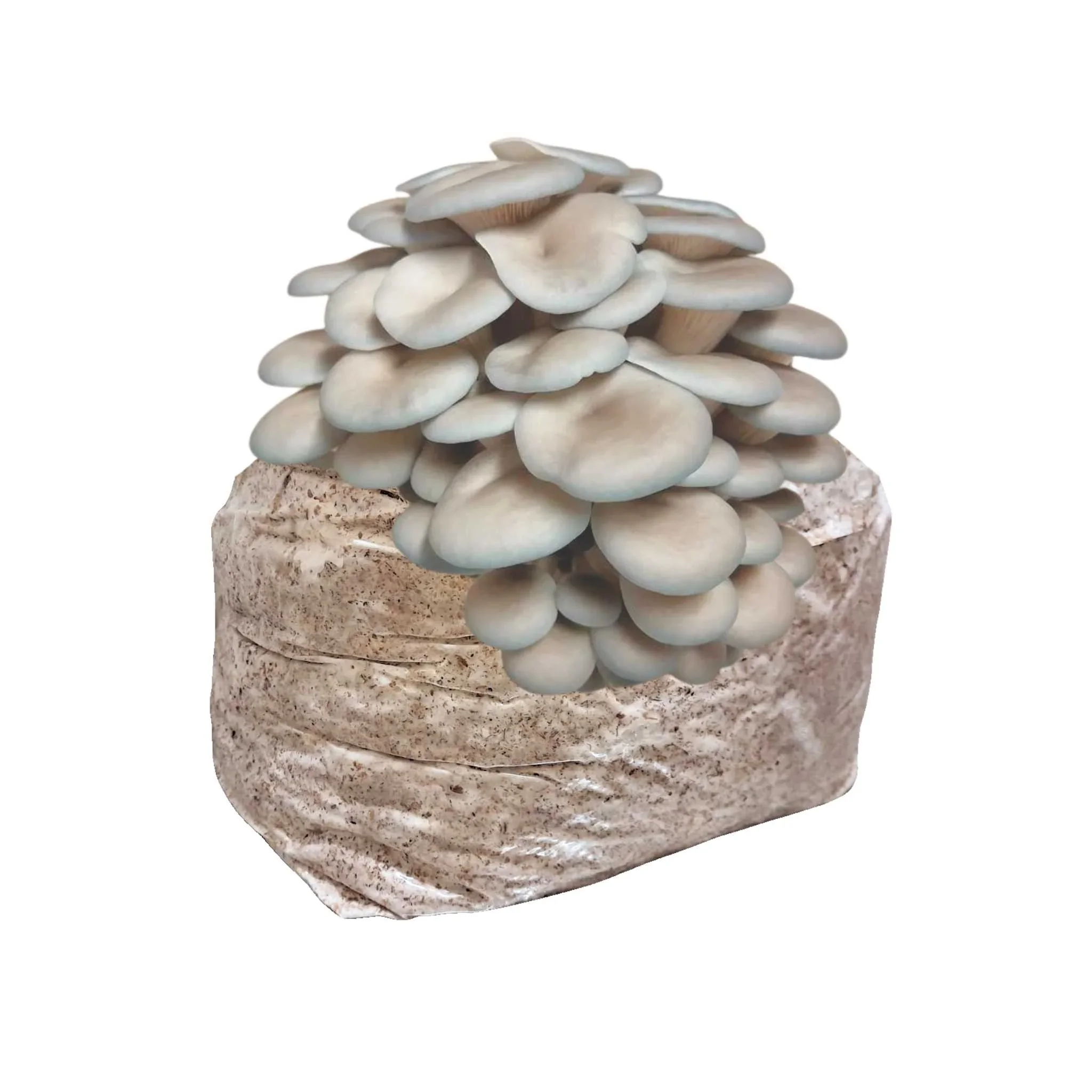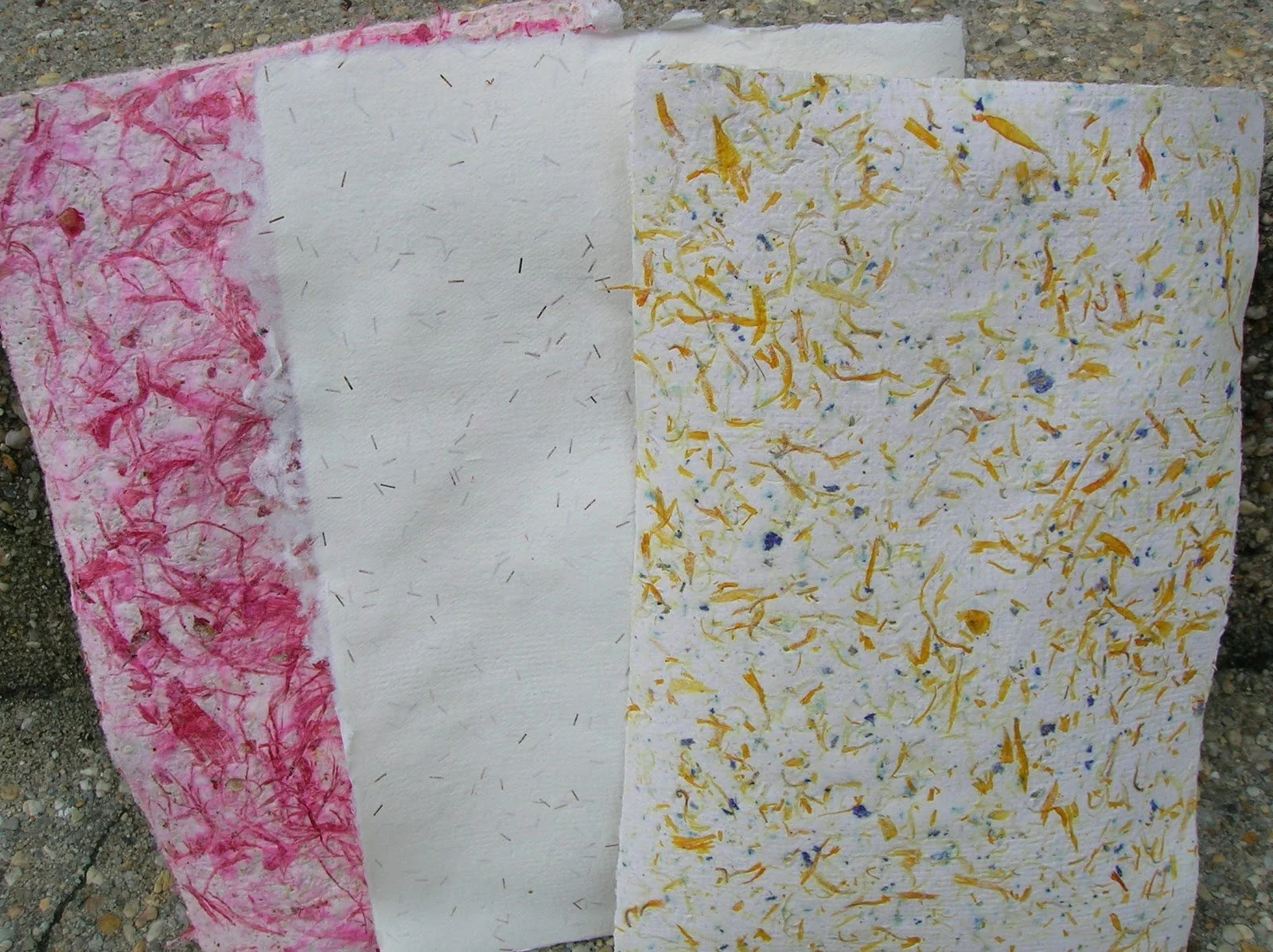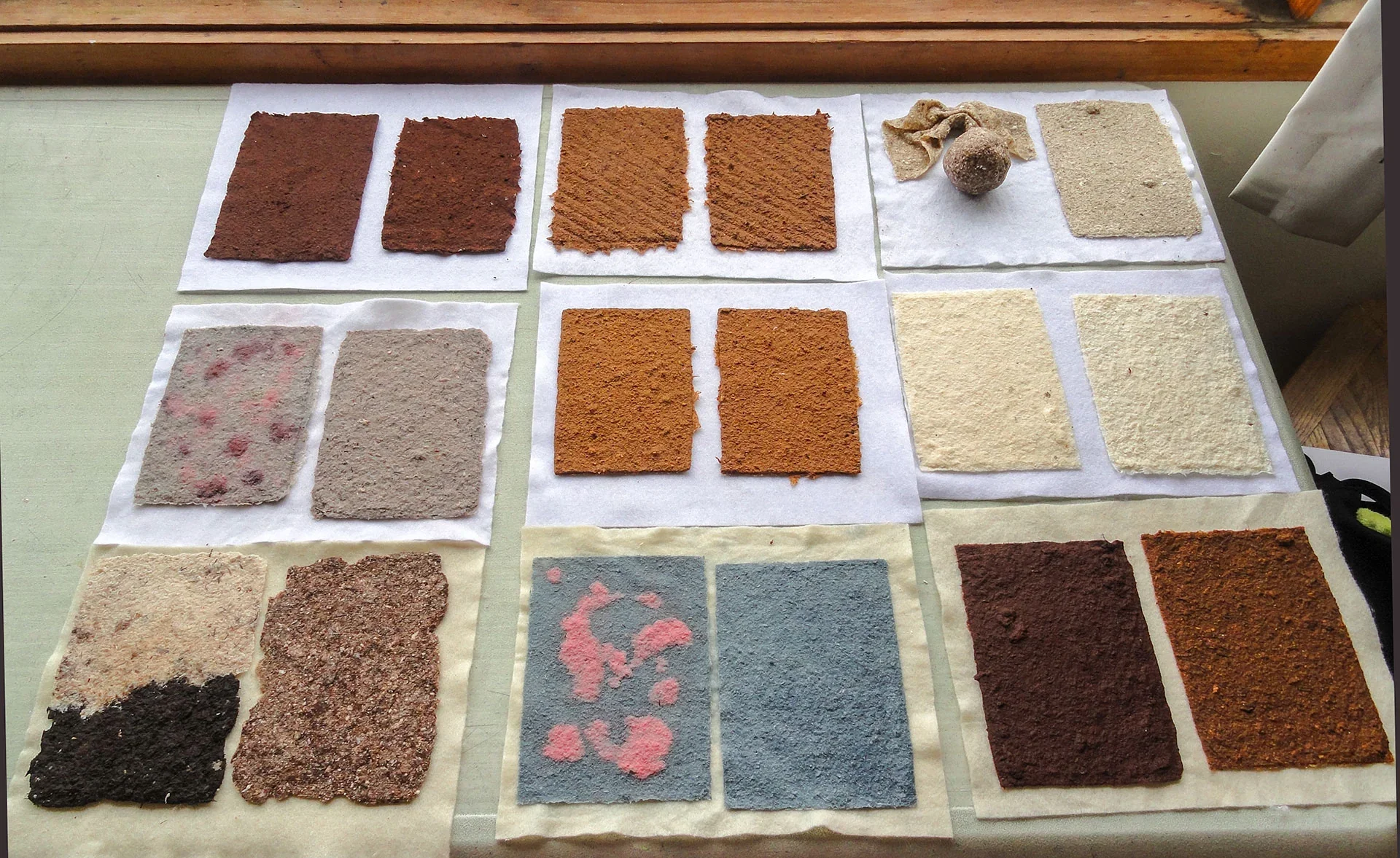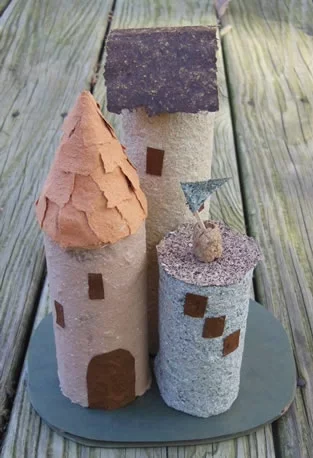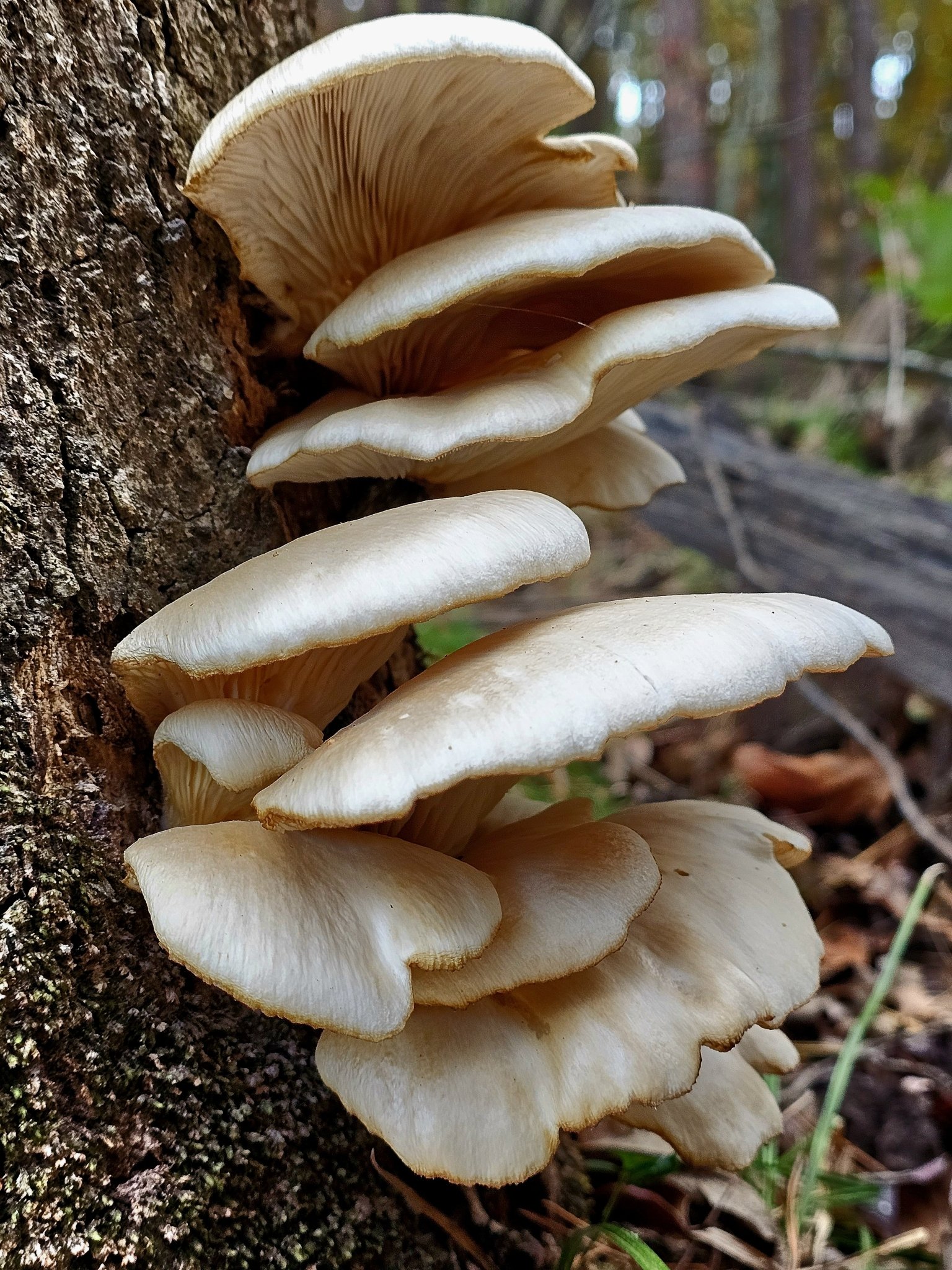How to ♼ Mushroom Blocks: FAQ's & Growing Tips
Learn how to use and grow mushrooms from recycled or “spent” mushroom blocks.
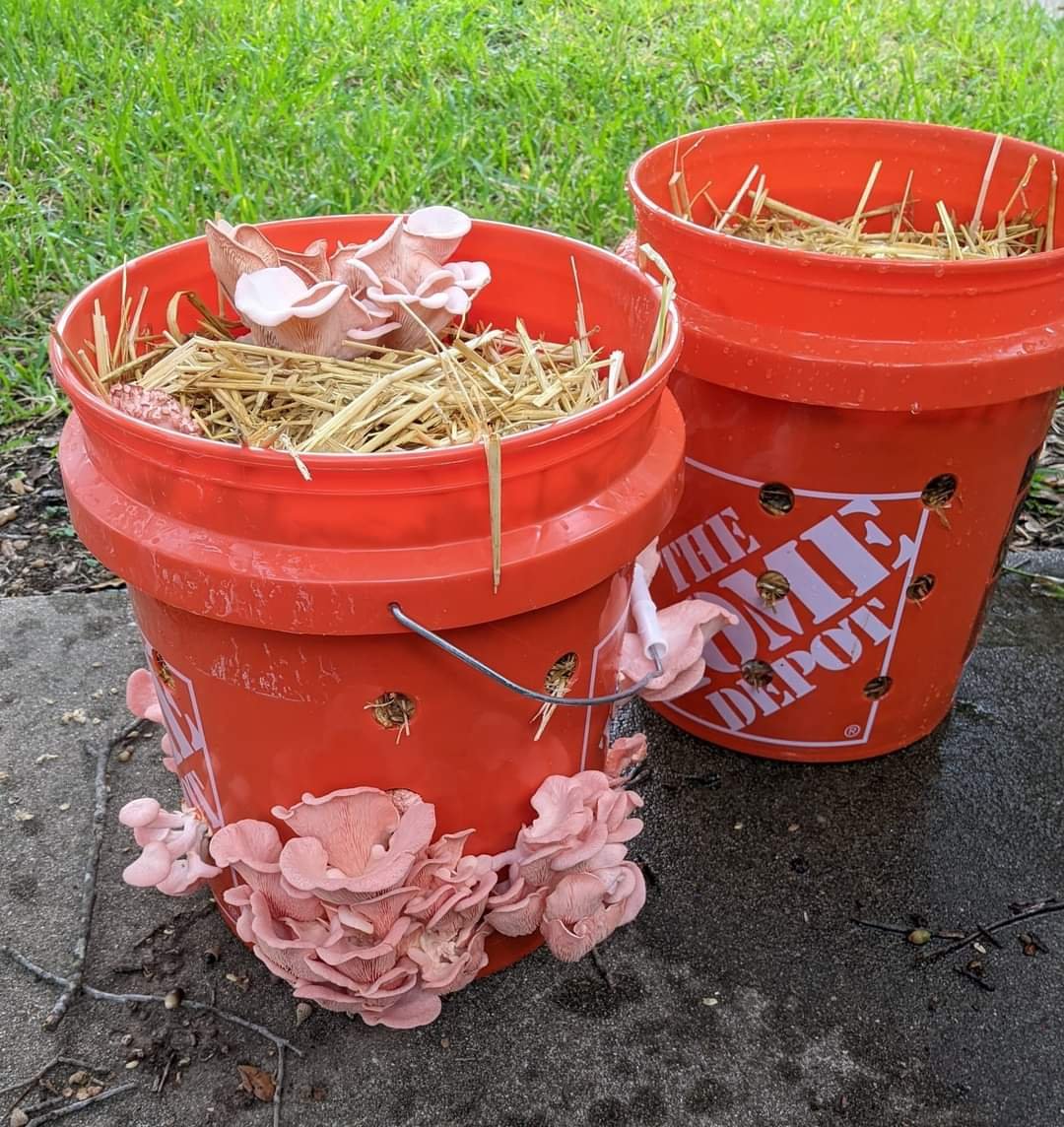
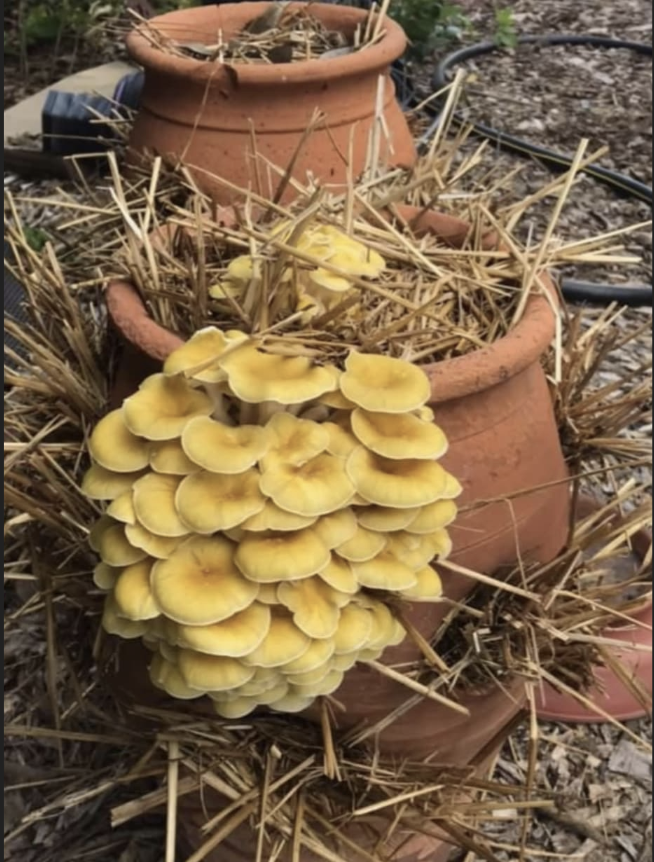
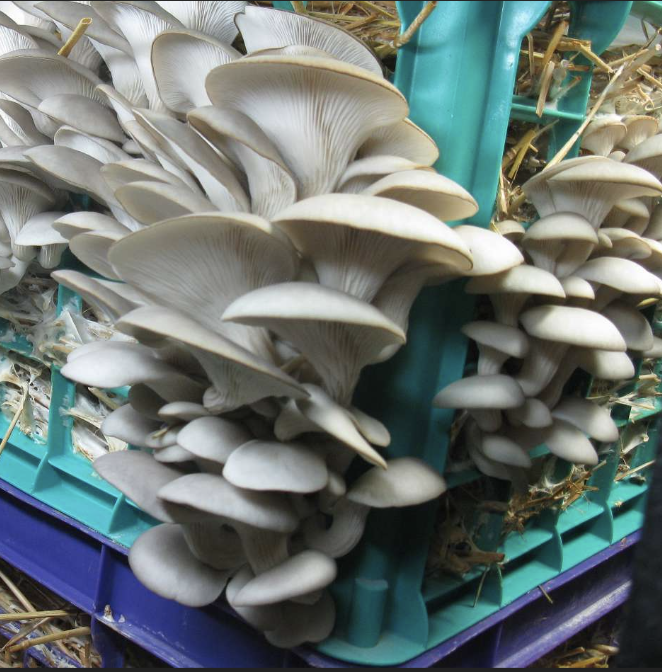
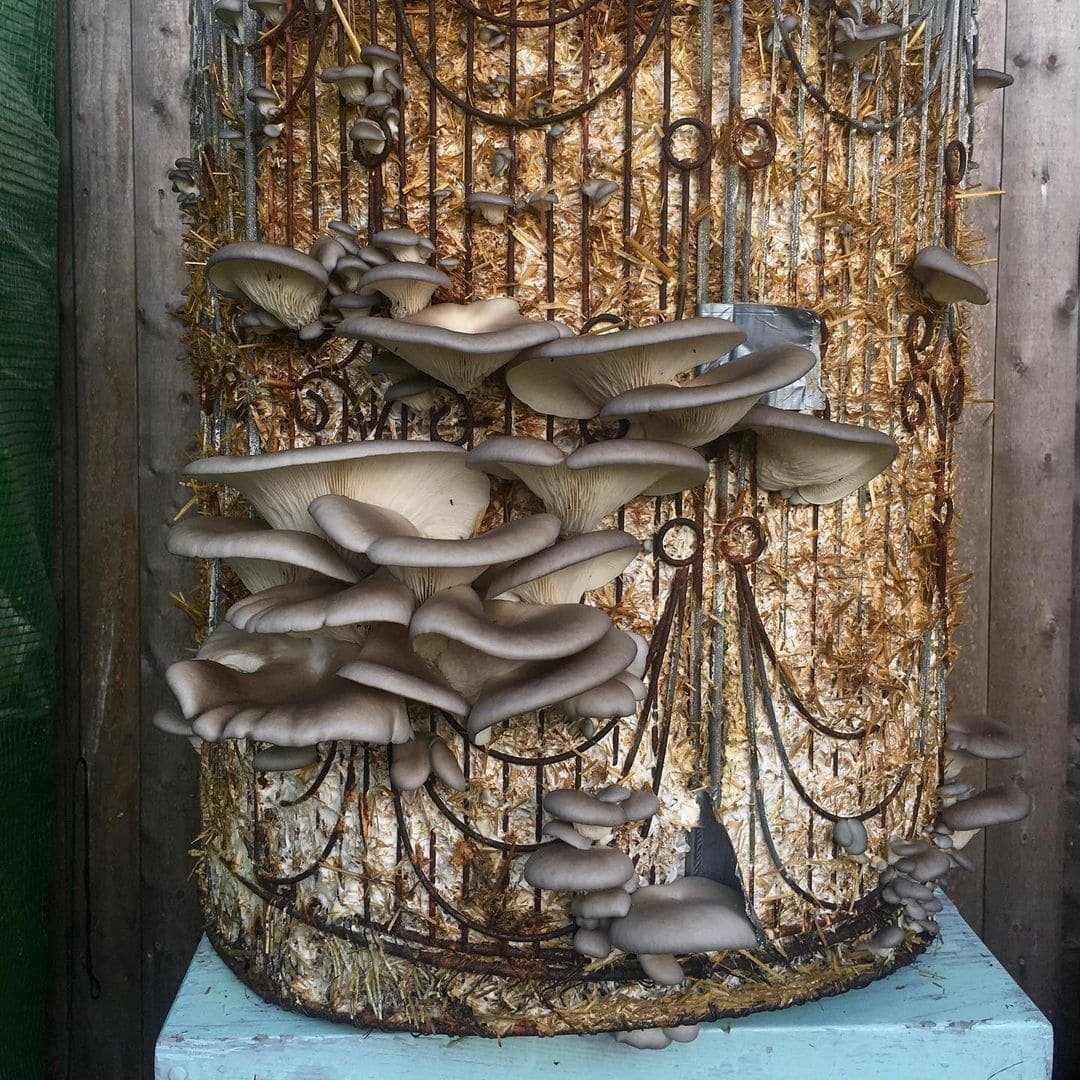
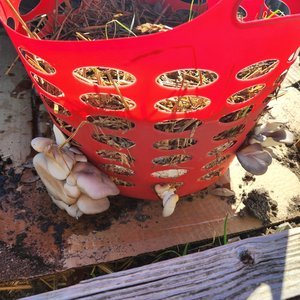
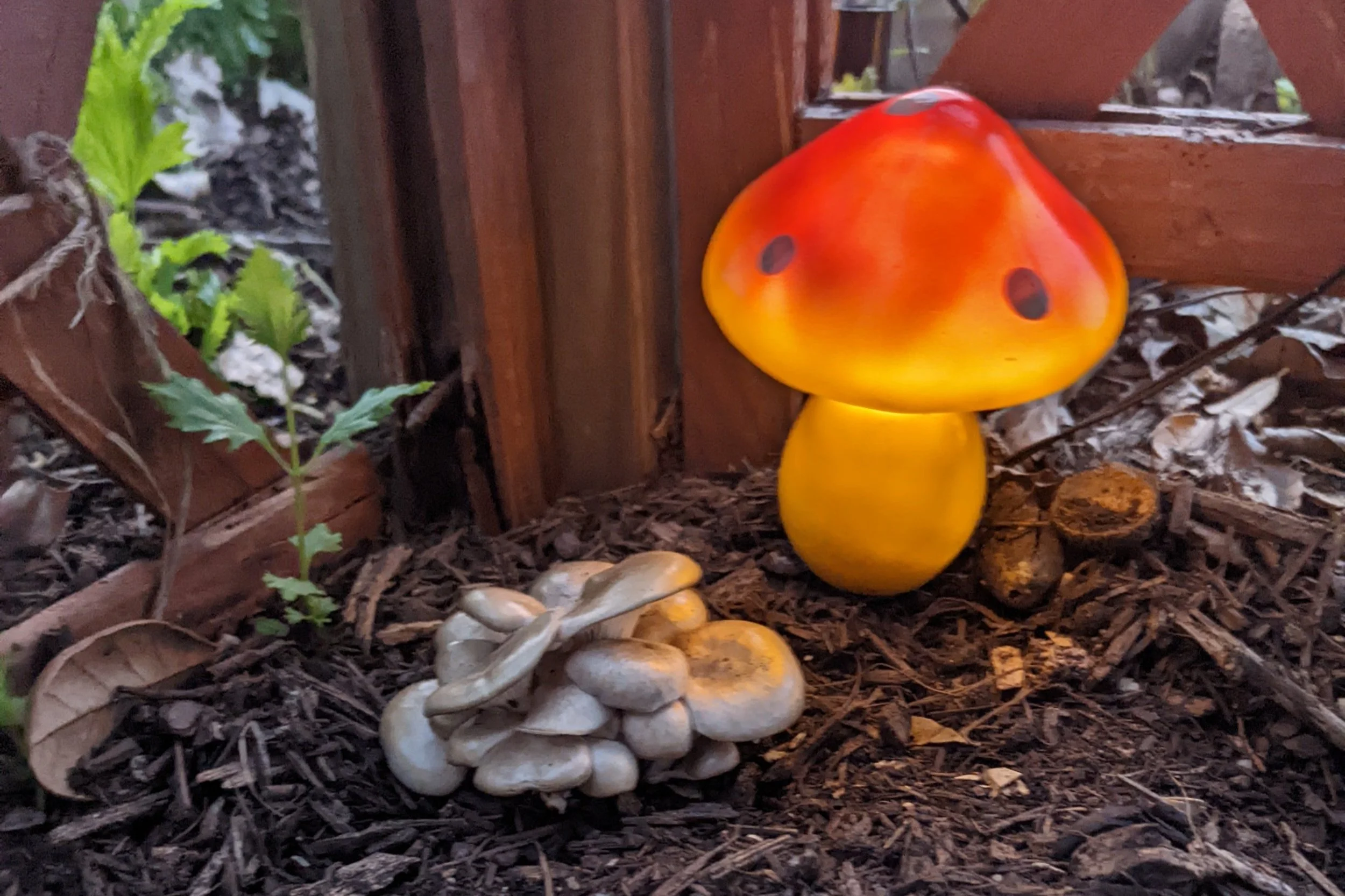
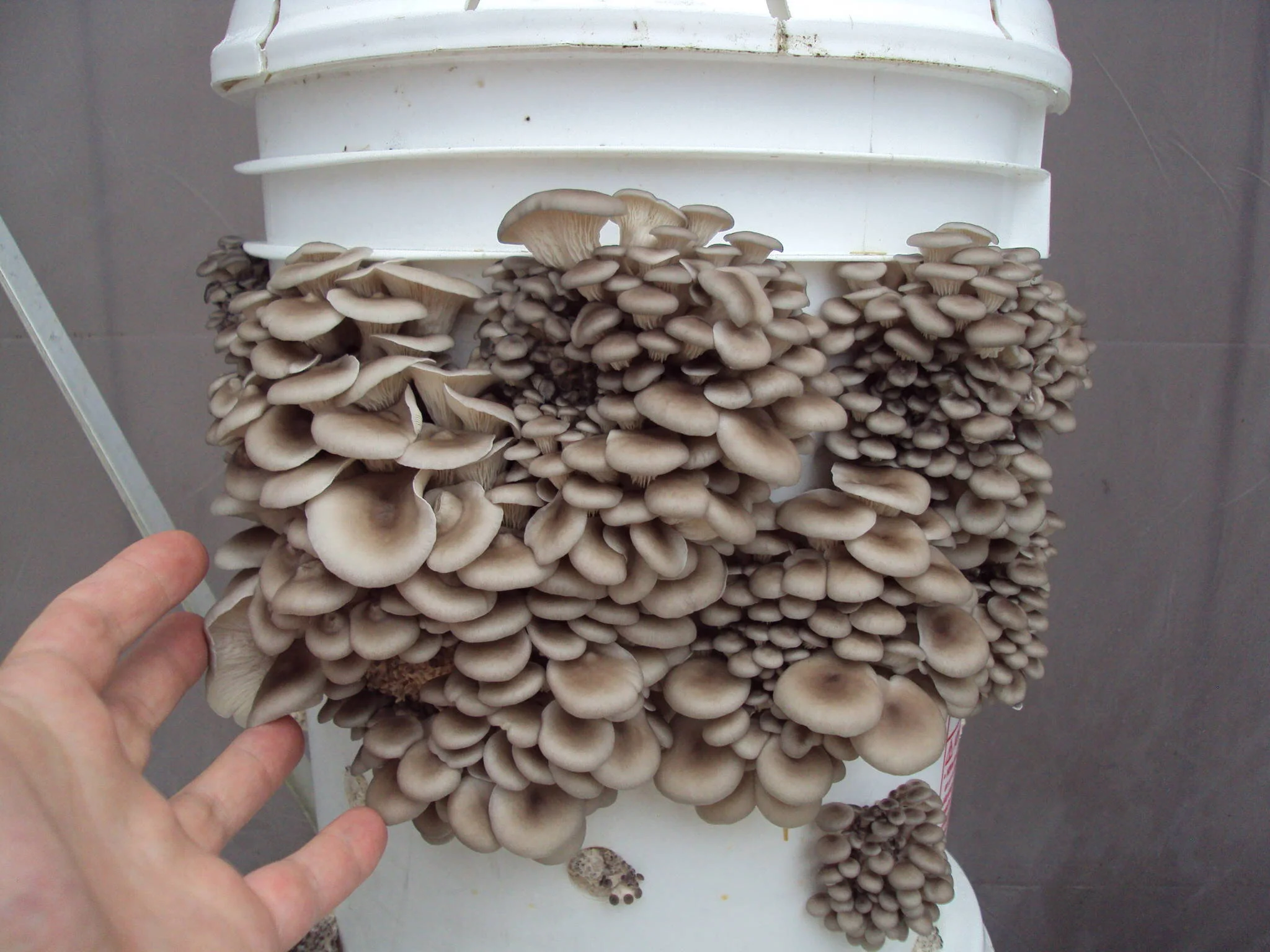

Frequently Asked Questions
What are mushroom blocks?
Commercial farmers grow culinary mushrooms in plastic grow bags filled with a sterilized, organic blend of sawdust, grains, and nutrients that feed the mycelium (white stuff). NO SALTS USED The bags are kept on shelves in a controlled environment that simulates the temperture (65-75°F) and humidity (80-90%) that is ideal for the mushrooms. Once the block is fully colonized and covered with mycelium, it is ready to fruit. The bags are cut open to allow in enough oxygen for the mushroom to fruit. After 3-7 days, the mushrooms are ready to harvest. The blocks are donated to be composted or to grow more mushrooms. This is why the bags are already open.
Where do they come from
From commercial mushroom farms in central Texas. Many times mushroom farms grow mushrooms once, and then end up getting tossed in the waste. In Austin, we are collaborating with a local mushroom farms to help keep used mushroom blocks out of the waste to give people the opportunity to grow them using various methods.
If you don’t live in Austin contact your local mushroom farm to see if you can take mushroom blocks to compost. Visit our map of Texas Mushroom Companies.
How do I grow another fruiting of mushrooms?
Keep mushroom block in the existing plastic bag and place out of direct light in a cool environment at 65-75°. A Martha Tent or Shotgun Fruiting Chamber is a great idea to contain the spores and helps create a humid environment when temperatures are too hot outdoors.
Spritz with water 2-3x per day
After about 2-3 weeks, the mycelium (white stuff) will start to develop “pins” or baby mushrooms.
Water more frequently and in 2-5 days a “flush” of mushrooms will be ready. Harvest with a knife before the caps curl up!
Compost after harvest.
Will mushroom blocks grow another mushroom that is poisonous?
No, a mushroom grow block will not randomly grow a poisonous mushroom. The block is inoculated with a specific fungal species, and unless contaminated by another fungus, it will only produce the intended mushroom. However, if once opened and exposed to wild spores, other fungi like green mold or trichoderma will colonize it. This fungus is really beneficial to plants and actual prevent other fungal pathogens. Learn more about benefits. Always have an expert identify any unexpected growth before consuming!
How to Use as Compost
Remove from plastic bag and dispose of plastic bag in the trash.
Break up the block and sprinkle it on your garden bed, mix it with mulch or wood chips, or add it to compost.
What are the benefits of using mushroom blocks in my garden?
Great for soil health
Supports the ecosystem
Keeps methane out of landfills (good for climate!)
Fill your belly with delicious and nutritious organic mushrooms for free
Support your local mush community!
Does the mushroom blocks contain salts that will hurt my plants?
NO! Many studies on mushroom compost like this one advise against using a lot of mushroom compost because they contain high salts. NO SALTS are used in the process of growing gourmet, culinary mushrooms like oysters and lions mane. These are WOOD-LOVING mushrooms and they grow on sawdust, grains and nutrients.
Mushroom farm such as Kitchen Pride (which we don’t work with) produce white button mushrooms such as cremini and portobello. These are DUNG-LOVING or mushrooms that grow on manure and have soluble salts used in the process. This type of compost contains high levels soluble salts that can harm young seedlings and kill germinating seeds. Since these are a very common mushroom grown and there are a lot of research and content about spent mushroom compost it appears at the top of search results.
When should I harvest?
Harvest mushrooms from a grow block when their caps start to flatten or their edges curl up, before they drop significant spores (oysters) or spines elongate too much (Lion's Mane), usually 3-7 days after pinning; the key is texture (firm, moist) and shape, not just size, and always pick the whole cluster at once for best quality.
If you harvest too late, they are still good for soups, oyster mushroom jerky and dehydrating and powdering. They flavor can be a little more bitter and texture more fibrous.
Left: caps still folded down, not dropping spores. Perfect to harvest
Right: edges flattened upwards. Dropping spores now, great to eat but take it outside
What kind of mushrooms are they?
Look for a tag with a code on the bag and also look at the hole in the bag to determine variety.
B- Blue Oysters
Pleurotus ostreatus
Flavor Profile: Sweet and meaty with hints of licorice. Perfect for braising, sautéing, roasting, frying, grilling, and stir-frying.
Z - Chocolate Oyster
Pleurotus ostreatus
Flavor Profile: A gourmet edible mushroom known for its velvety, dark cocoa-brown caps and firm white stems.
D-Black Pearl
Pleurotus ostreatus
Flavor Profile: Meaty yet airy flavor with hints of sweetness. When cooked, it packs a savory punch and is a reliable ingredient for adding umami flavor to a dish.
L - Lions Mane
Hericium erinaceus
Flavor Profile: Tender texture that mimics shellfish like scallops, crab, or lobster. A great alternative to seafood. Read about medicinal values.
A-Local Oyster
Pleurotus ostreatus
Flavor Profile: Some people report a seafood-like taste while others just say woodsy — it probably varies a bit depending on the environment it is growing
P - Pink Oyster
Pleurotus djamor
Flavor Profile: Taste like bacon or ham, and the flavor intensifies when cooked. The aroma is pungent and meaty wonderful meat substitute in many dishes.
C-Chestnut
Pholiota adiposa
Flavor Profile: Earthy aroma and mildly sweet flavor with distinct hints of nuttiness. Commonly compare their flavor to shiitakes.
O-Pioppini
Cyclocybe aegerita
Flavor Profile: Earthy, nutty flavor with subtly sweet, floral, and peppery note. Popular in pasta dishes and risotto.
Less Common Variety Codes: Y: Yellow Oyster P: Pink Oyster, MA: Maitake, SH: Shiitake E: Enoki
Growing Tips
Indoors: (Anytime)
Leave in the bag and put in moist area like a kitchen or in bathroom. A Martha Tent or Shotgun Fruiting Chamber is a great idea to contain the spores and helps create a humid environment when temperatures are too hot outdoors. Growing mushrooms indoors is not recommended at scale unless you can contain the spores in a fruiting chamber. Growing a few blocks indoors and under supervision is safe. (See allergy precaution below.)
Air circulation is important. Turn on overhead fan or place fan facing away from mushrooms.
Keep Moist: Spritz with water on slit daily. Keep an eye out for pins (tiny mushies), water 2 - 3x a day.
Harvest after 3 - 5 days before the caps start to curl up and spores drop.
Compost or use as mulch in garden.
Outdoors: (Late Fall-Early Spring)
Once temps are below 80 degrees you can leave the block in the existing bag and place it in a shady spot under a tree or shrub, on your porch.
Keep it moist, water daily. They love rain water so make sure they can get exposed.
Keep an eye out for pins (tiny mushies), water 2-3x a day.
Harvest after 3 - 5 days before the caps start to curl up.
Compost or use as mulch in garden.
Key Elements for a Successful Grow
Humidity
Ideal humidity is 80-90% so spray with filtered water 2-3 times a day and keep in a humid area. Try putting them inside a cardboard box or container to contain humidity. Just remember air flow and light are also important.
Air Circulation
Mushrooms give off carbon dioxide and intake oxygen so give them a space for air circulation.
If you see green, black, or orange moldy spots, then feed the block to your compost. Green mold is great for plant growth.
Light
During the colonizing stage (3+ weeks), keep your mushrooms in a cool, dark place below 80°. Once you see “pins” aka baby mushrooms, give your mushroom more light and oxygen. UV light is how mushrooms create vitamin D.
More Growing Tips
Fold the bag over the slit to retain moisture until you see tiny mushrooms. If possible, keep the square white filter patch directly accessible for airflow.
Spritz water around the mushrooms (not directly) for best results.
Mushroom blocks make liquid over time! Just pour it out!
After a few times fruiting, the block will be done. Unbag, smash, and compost!
Important Allergy Precaution
Spores can cause problems indoors for people with allergies. Keeping them in sight is important. If you are going out of town for an extended period put them outside because mushrooms can grow and spread spores in 5-7 days. If you see any mold forming on your block, use a spoon to break it off and dispose of it immediately outdoors. Mold spores, like mushroom spores, are not good to inhale in large quantities.
How to support this program:
Help us continue to keep 10,000+ blocks out the waste by leaving us a donation. (Suggestion is $5 per block).
Tag us online with pics of your mushroom growing experiments OR share your story here.
December Mushroom of the Month: Fly Agaric, Amanita muscaria
The December Mushroom of the Month is the Fly Agaric, Amanita muscaria.





🍄⭐The December mushroom of the month is the Fly Agaric, Amanita muscaria
👏 Congrats to Candice for guessing it right and winning a membership to the society! 🎉
You can also be a supporting member to stay dialed-in with events & discover next month’s mystery mushroom.
Cultural Icon
The Fly Agaric is one of those rare species known equally well by its scientific name, Amanita muscaria. It’s iconic red and white cap has made it a pop culture fav. Beyond that, it has a rich history of human use that reaches deep into the past. It has been associated with Santa Claus, who may have been a Siberian shaman, mysterious elixirs (like the soma of the Hindu Vedas) and even Jesus Christ (John Marco Allegro, The Sacred Mushroom and the Cross). Today, its medical benefits are being rediscovered by a new crop of ethnomycologists and entrepreneurs.
Taxonomy + ID
Amanita muscaria is a widely distributed mushroom native to temperate and boreal forests of the Northern Hemisphere, now also naturalized in the Southern Hemisphere, forming mycorrhizal relationships with various trees, especially firs and spruces.
The mushroom emerges as white eggs. Its maturing cap is covered with small, pyramid-shaped warts—these are remnants of the universal veil, a membrane that encloses the entire mushroom when it is still very young.
As it grows, the red colour appears and the warts become less prominent. The cap changes from globose to plate-like (2–12" wide). Age and rain can fade the colour and wash the warts away.
Mythical + Medicinal
Amanita muscaria’s link to Christmas traces back to Siberian shamans using it as an entheogen during the Winter Solstice. They delivered dried mushrooms to villagers, a process that converts ibotenic acid into more potent muscimol. This mushroom has also been postulated as the ingredient in the Vedic elixir, soma, and connected to early Christianity.
While muscimol is psychoactive, in small doses it has a wide range of medicinal benefits, including mood enhancement and relief from anxiety. There are a wide range of products on the market today that contain Amanita muscaria extract, but as the market is fairly unregulated it is highly suggested to research potential products and purchase from vetted companies.
Become a Supporting Member and stay dialed in with events & discover next month’s mystery mushroom.
How to Make Paper from a Spent Mushroom Block
This guide walks you through the simple process of turning what could have been organic waste “spent mushroom substrate”, into beautiful, textured paper for art, journaling, or gifts.
Introduction
We’re always looking for creative ways to close the loop in our fungal lifecycle. One of our favorite projects is transforming spent mushroom blocks into unique, fibrous handmade paper. Spent substrate—the leftover sawdust or straw after mushrooms have fruited—is often rich in mycelium and cellulose, making it a perfect, sustainable base for papermaking.
Mushroom paper, also known as mycelium paper or fungal paper, is an innovative, sustainable material made from the root-like structure of mushrooms (mycelium). It’s biodegradable, surprisingly durable, and has a unique, organic texture.
This guide walks you through the simple process of turning what could have been organic waste “spent mushroom substrate”, into beautiful, textured paper for art, journaling, or gifts.
Why Make Paper from Spent Substrate?
Zero Waste: Repurpose your spent blocks from our Community Supported Mushroom Block Rescue into something new.
Eco-Friendly: Reduce your footprint by avoiding new paper pulp.
Unique Texture: The mycelium and organic matter create beautifully textured, speckled paper with a story.
Educational Fun: A perfect activity —combining mycology, art, and hands-on science.
What You’ll Need
Most of these supplies can be found around the house or at local Austin shops like Austin Creative Reuse.
Materials:
Spent mushroom substrate – from your own grows or rescued via our Block Rescue Program. Oysters are the most common and best variety to use.
Blender or food processor (dedicated to crafting)
Large plastic tub or basin
Mold and deckle – the classic papermaking screen set. You can make one by stretching fine mesh (like window screen) over two wooden frames of identical size.
Couching cloths – felt, smooth towels, or pillowcases
Sponges
Pressing boards or heavy books
Optional add-ins: recycled paper scraps, dried flowers, native seeds, or natural dyes made from foraged plants
Step-by-Step Process
Step 1: Get a Mushroom Block
Break up your spent oyster mushroom block. Remove any large chunks of undecomposed wood or moldy parts. This material is great for the compost.
Soak the substrate in warm water for a few hours to soften the mycelium and fibers.
Step 2: Make Pulp
Drain the substrate and add it to your blender in small batches.
Cover with clean water and blend until you achieve a slurry with a fine, fibrous consistency. Think “fungal smoothie.”
Step 3: Prepare Slurry
Pour the pulp into your large tub and mix with more water. The more pulp you add, the thicker your paper will be.
Step 4: Form Sheets
Submerge your mold and deckle into the pulp mixture, then lift it level while letting the water drain.
You should see a thin, even layer of pulp on the screen. If it’s too thin, add more pulp to the vat; if too thick, add more water and stir.
Carefully remove the deckle and gently press a couching cloth onto the wet sheet. Use a sponge to absorb excess water through the screen.
Step 5: Couching
Flip the mold onto a flat surface and peel the screen away, leaving the wet paper on the cloth.
Layer another cloth on top if making multiple sheets.
Place the stack between boards and apply weight (books work great). Press for 12–24 hours.
Step 6: Drying
Gently peel your paper from the cloth and air-dry on a rack or clothesline.
For flat paper, you can iron on low heat between parchment paper once it’s mostly dry.
Tips for Success
Experimentation is key: Try different mushroom species, substrates, and pulp blending times to vary texture, strength, and color. Ganoderma or Reishi which grows in the wild and is common in Texas is really great for paper making.
Thinner sheets dry faster and are more flexible; thicker sheets are sturdier but may take longer to dry evenly.
Add inclusions: Blend in recycled paper, plant fibers, or dried flowers for unique effects. You even can mix in plants like grass and flowers like marigolds to achieve different colors. You can even add dried plants and mushrooms at Step 4 for adding more artful textures and collages.
Safety Notes
Use a blender dedicated to crafts, not food.
Work in a well-ventilated area when handling dry substrates.
Some people may be sensitive to fungal spores; wear a mask if concerned.
Never consume the mycelium or paper unless you are using a known edible species and have not added any non-food materials.
Troubleshooting
Mold contamination (green/black spots): Sometimes mushroom blocks have contamination of green mold. Compost these and find a block that is white with healthy mycelium.
Mycelium won’t form a mat: The substrate may be too wet/dry, or temperature is off.
Paper tears easily: The pulp may be too fine, or the sheet was too thin. Try a longer fiber blend or a thicker pour.
Paper is too thick/c lumpy: Blend longer, use more water in the vat, or stir more vigorously before pulling a sheet.
Creating paper from mushrooms is a fascinating blend of mycology and traditional craft. Each batch is unique, reflecting the natural variability of fungal growth. Enjoy the process and the beautiful, earth-friendly material you create!
Giving Tuesday: 5 Ways to Support Mycology Education
There are so many different ways to show generosity on #GivingTuesday and support mycology education.
Here are 5 ways you can support our mission to spread fungal knowledge:
✦ GIVING TUESDAY ✦
There are so many different ways to show generosity on #GivingTuesday and support mycology education.
Here are 5 ways you can support our mission to spread fungal knowledge:
Become a Supporting Member – Join our community and grow with us!
Volunteer with the Block Rescue – Help us rescue mushroom blocks and keep them out of landfills.
Make a One-time Donation – Every contribution helps fund our programs and outreach. Choose our non-profit for a corporate gift matching.
Shop our Gift Guide – Support small business and spread myco love
Partner with Us – We would love to partner with you in myco education. Reach out to us for your next event!
We are a community powered non-profit and all we do is because of you! Thank you for your support today and every day!
November Mushroom of the Month: Icing Sugar Fungus, Beauveria bassiana
The November Mushroom of the Month is the Icing Sugar Fungus, Beauveria bassiana





🍄⭐The November mushroom of the month is the Icing Sugar Fungus, Beauveria bassiana
👏 Congrats to James for guessing it right and winning a membership to the society! 🎉
You can also be a supporting member to stay dialed-in with events & discover next month’s mystery mushroom.
A Microscopic Menance
Beauveria bassiana is a white mold fungus that grows in soils around the world. It is parasitic on various arthropod species, causing causing white muscardine disease, making it an entomo-pathogenic fungus. The species is named after the Italian entomologist Agostino Bassi, who discovered it in 1835 in silkworms. Bassi performed the first infection experi-ments, and determined the fungus to be the cause of the muscardine disease, which then led to carriers transmitting it by airborne means.
Taxonomy
When spores of B. bassiana come in contact with a suitable insect host it produces a white mold that resembles frost, or frosting on a cake, giving it the name Icing Sugar Fungus. The white spore balls are made up of many conidia that are single-celled, haploid, and hydrophobic.
Microscopic identification: The short, ovoid conidiogenous cells that produce the conidia have a narrow apical extension called a rachis, which elongates into a long zig-zag extension.
Field identification: Insects that appear to be whimsically decorated with frosting but are actually dead and covered with mold.
A Gardner’s New Best Friend
Beauveria bassiana may be a menace to arthropods, but it’s a fantastic ally for gardeners. Researchers quickly recognized its potential for insect control, especially since it’s harmless to humans and other non-arthropods. When spores are applied to leaves, soil, or seeds, they remain active until encountering a susceptible insect host.
The spores germinate and produce hyphae that penetrate the insect’s cuticle and invade its body. Inside, the fungus multiplies and kills the host. B. bassiana is highly valued in agriculture for its versatility and is being studied as a biological insecticide against termites, whiteflies, and other pests, as well as for controlling malaria-transmitting mosquitoes.
Become a Supporting Member and stay dialed in with events & discover next month’s mystery mushroom.
November Foraging Forecast
Learn wild, edible mushrooms fruiting in Texas after rain.
Learn wild, edible mushrooms fruiting in Texas after rain.
Comes with download of a Wild Edible Mushroom Calendar.
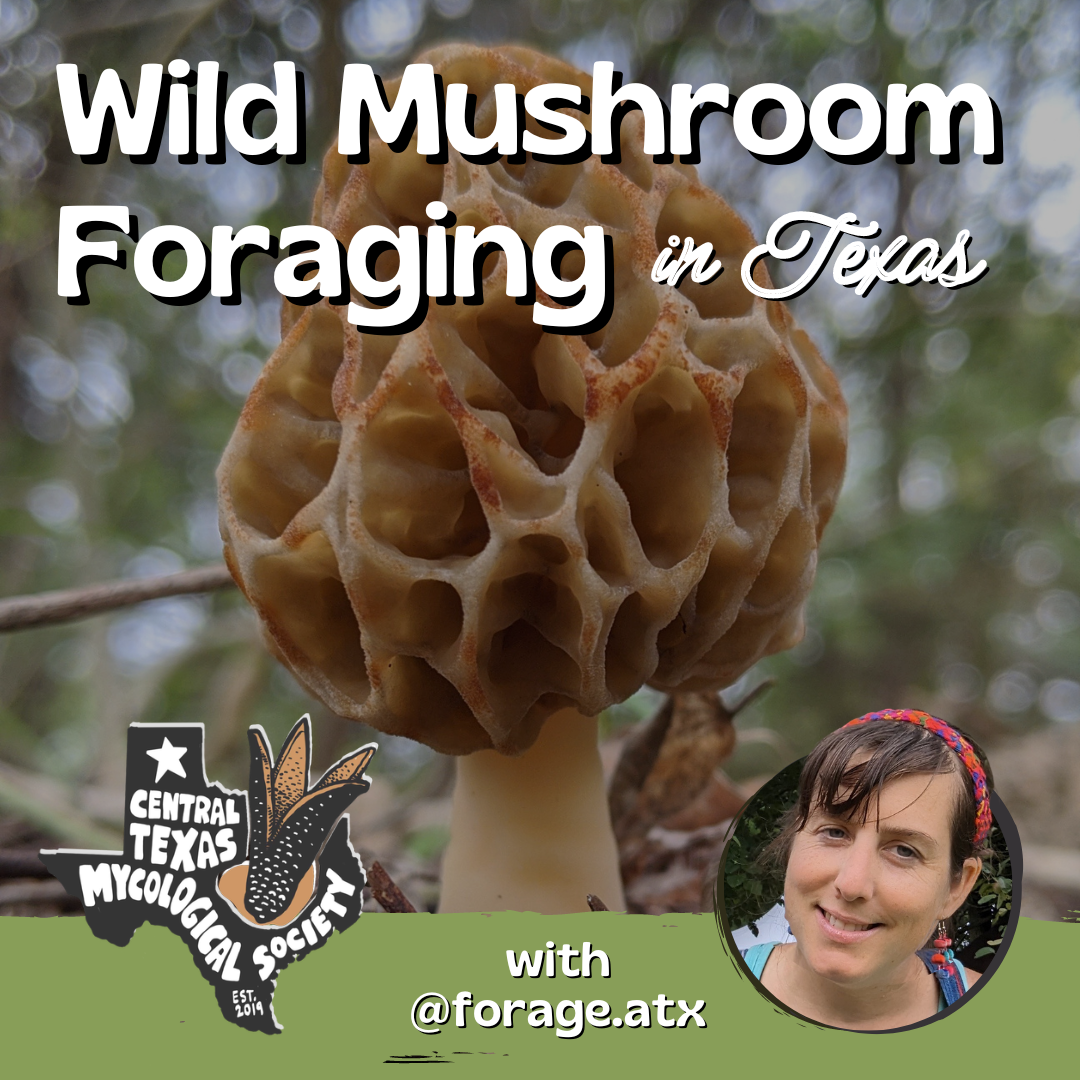
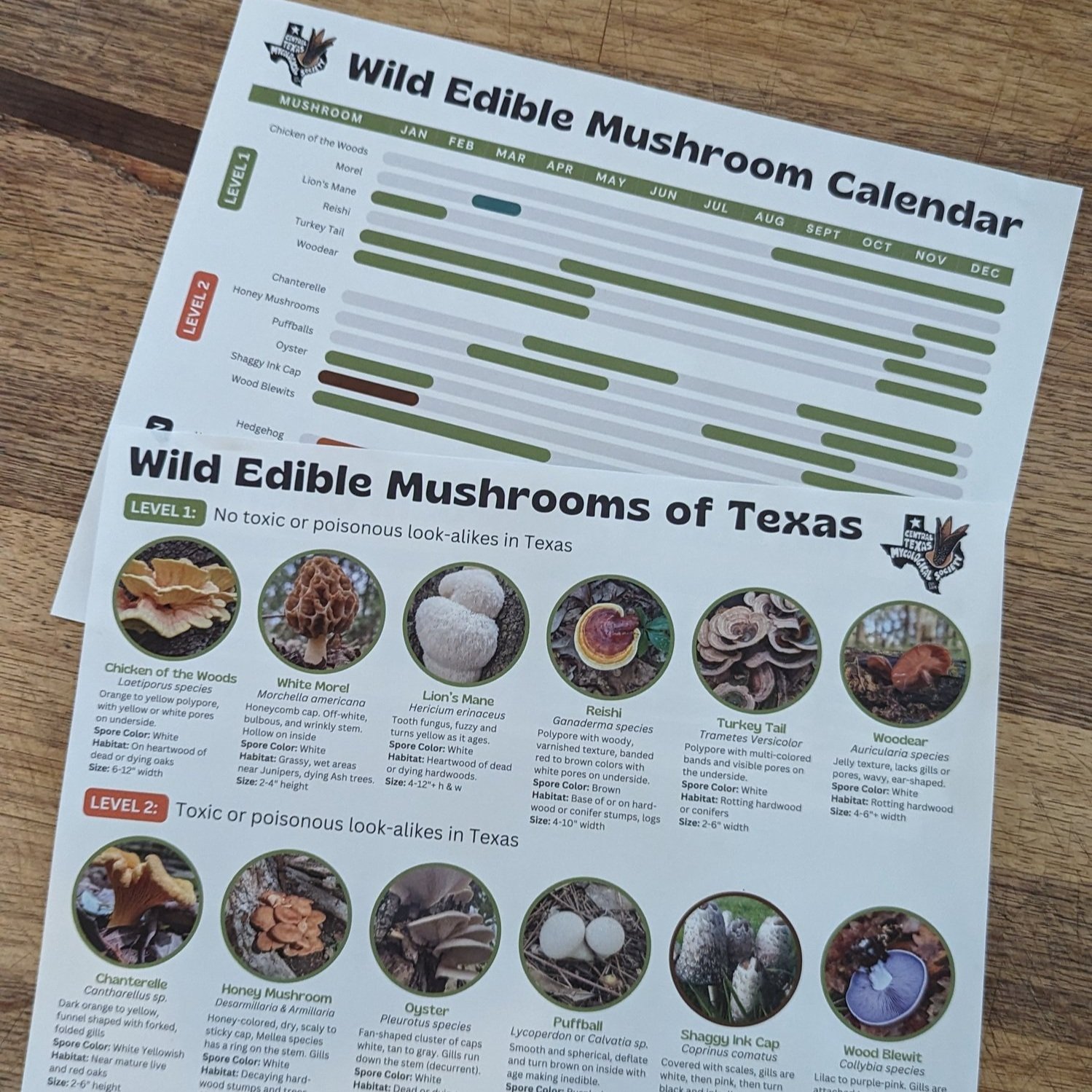
OYSTER: Pleurotus ostreatus
DESCRIPTION: Color can vary white, tan and gray.White to cream gills, run down stem.
HABITAT: Grows in clusters and decomposes hardwood.
SPORE COLOR: White
SIZE: Cap fan shaped, 2"-8" across.
EDIBILITY: Choice. Delicious meat replacement in all types of cuisines
LOOK A-LIKE: The Southern Jack-o-lantern, Omphalotus subilludens is the toxic look-a-like and is orange to brown in color. They do grow at the same time but their habitat and morphology is different.
Chicken of the Woods: Laetiporus, 4 species in texas
DESCRIPTION: Orange to yellow polypore, with yellow or white pores on underside.
Habitat: Grows in shelfs on heartwood of dead or dying oaks.
Spore Color: White Size: 6-12" width
Edibility: Contains proteins, fat, fiber and tastes just like chicken! Harvest when young, colorful, and moist. Becomes lighter in color, fiborus, mealy and dry, inedible with age.
Look-alikes: Shaggy Bracket, Inonotus hispidus (non-toxic)
Ringless Honey Mushroom: Desarmillaria & ArmillariA Species
Ringless Honey Mushroom, Desarmillaria caespitosa will start been popping up all over Austin in large clusters at the bases of trees (when the clusters appear to be terrestrial they are actually growing from underground wood) in late summer and fall. This parasitic fungus is part of a genus that is the largest living organism ever found on this planet.
Description: Honey-colored, dry, scaly to sticky cap. Mellea species has a ring on the stem. Gills, some species have a ring.
Habitat: Grows in clusters on decaying hard-wood.
Spore Color: White
Size: 6" in Height
Edibility: Not Choice.
Look-alikes: Southern Jack-o-lantern, Omphalotus subilludens which is toxic and orange to brown in color.
REISHI: Ganoderma, 12 species in Texas
DESCRIPTION: Polypore with woody, varnished texture, banded red to brown colors with white pores on underside.
HABITAT: Grows at base or on hardwood stumps, logs, especially oaks and pecan. Pines in East Texas.
SPORE COLOR: Brown
SIZE: 4-10" width
EDIBILITY: Medicinal. Very bitter because of medicinal compounds.
LOOK-ALIKES: Red-Belted Conk, Fomitosis Pinicola (also medicinal).
honeycomb fungus: FavoluS 3 species in Texas
DESCRIPTION: Genus of tropical fungi in the family Polyporaceae but with fleshy with radially arranged pores on the underside of the cap that are angular and deeply pitted, somewhat resembling a honeycomb. White to yellow and grows alone or in overlapping clusters similar to oyster mushrooms or other shelf fungi.
HABITAT: On decaying hard-wood, year round when humidity is high after rain.
SPORE COLOR: White
SIZE: 3-6" wide
EDIBILITY: Odor slightly foul, especially in rehydrated material; taste not distinctive. Tough texture and can be cooked like chicharrones.
LOOK A-LIKE: Oysters, Pluerotus or Lentinellus cochleatus (none observed in Texas) but grow on decomposing wood.
WOOD EAR: Auricularia 6+- species in Texas
DESCRIPTION: Brown to amber in color. Jelly texture that is irregular, wavy, and ear-shaped. Lacks gills or pores.
HABITAT: Grows in clusters on decaying hardwood after rain
SPORE COLOR: White
SIZE: 4-6" in width and > 1/4" thick
EDIBILITY: Wood ear mushrooms are a popular ingredient in many Chinese dishes, such as hot and sour soup, and also used in Chinese medicine. It is also used in Ghana, as a blood tonic. Modern research into possible medical applications has variously concluded that wood ear has anti-tumor, hypoglycemic, anticoagulant and cholesterol-lowering properties.
LOOK-ALIKES: Amber Jelly, Exidia recisa which is also edible.
Puffball: Lycoperdon and Calvatia, 15+- species in Texas
DESCRIPTION: Smooth and spherical, deflate and turn purplish or brown on inside with age making inedible. Some peal and have spines.
HABITAT: Overgrazed Prairie or grasslands.
SPORE COLOR: Purple-brown
SIZE: 2- 60" diameter
EDIBILITY: Doesn’t have a strong flavor of its own and absorb flavors. Try making a Giant Puffball Pizza.
LOOK-ALIKES: Amanita species which can contain toxins and be fatal. If center of puffball is not white, it can cause GI distress.
Blue Milkcap: Lactarius Indigo
DESCRIPTION: Blue cap with concentric rings and a depression in center, sticky or slimy to the touch. Brittle flesh, stem. Gills and body exude blue latex when injured tissue is and stains the wounded tissue greenish blue.
HABITAT: Mycorrhizal and grows in deciduous and coniferous forests.
SPORE COLOR: Cream
SIZE: 2.0–5.9" cap width
EDIBILITY: Choice. Peppery taste and has a coarse, grainy texture.
LOOK-ALIKES: Blewit, Collybia nuda or Lactarius paradoxus (edible)
CHANTERELLE: Cantharellus, 10+- species in Texas
DESCRIPTION: Red, orange, yellow to white, meaty and funnel-shaped and can be found in clusters or individual mushrooms. On the lower surface, underneath the smooth cap, most species have rounded, forked folds that run almost all the way down the stipe, which tapers down seamlessly from the cap.
HABITAT: Symbiotic and found around 5-30 feet of mature live and red oaks after a lot of rain. Chanterelles need a lot of rain to fruit and they like the torrential Texas-style flash floods. Trees near creeks and where water is flowing downhill is very important. Avoid trees that are in areas that are mowed. Trees with undisturbed leaf matter and not many understory plants are ideal.
SPORE COLOR: White Yellowish
SIZE: 2-6" height
EDIBILITY: Choice. Many species emit a fruity aroma, reminiscent of apricots, and often have a mildly peppery taste.
LOOK A-LIKE: The Southern Jack-o-lantern, Omphalotus subilludens is the toxic look-a-like and is orange to brown in color. They do grow at the same time but their habitat and morphology is different.
TURKEY TAIL Trametes versicolor
DESCRIPTION: Variable coloration, distinct striping pattern. No gills, pores are small and round, white to light brown
HABITAT: Grows in overlapping clusters on logs and stumps
SPORE COLOR: White
SIZE: Cap fan shaped, 2"-8" across.
EDIBILITY: Medicinal. Tough, leathery flesh. Can be brewed into a tea, broth, or extracted into a tincture.
LOOK A-LIKE: False turkey tail. or Stereum ostrea and is non-toxic. Mushroom Expert has a useful check list to determine if it is true medicinal turkey tail.
Become a member and learn more about wild mushroom foraging in Texas!
Membership benefits include early access and discounts to walks, workshops, and more. Your membership helps support the larger community! Tag us to get help with ID and add your observations to iNaturalist.org. If you are trying a new mushroom, confirm the ID with an expert, then try a small amount to make sure you don't have an allergic reaction. Texas Mushroom Identification Facebook group is great for quick responses and ID help. Also, don't forget to add your finds on the Mushrooms of Texas project on iNaturalist.
Follow my adventures @forage.atx.
October Mushroom of the Month: Hairy Hexagonia, Hexagonia hydnoides
The October Mushroom of the Month is the Hairy Hexagonia, Hexagonia hydnoides





🍄⭐The October mushroom of the month is the Hairy Hexagonia, Hexagonia hydnoides
👏 Congrats to Juan for guessing it right and winning a membership to the society! 🎉
You can also be a supporting member to stay dialed-in with events & discover next month’s mystery mushroom.
A HAIRY SITUATION
It doesn’t take much imagination to see how the hairy hexagonia, aka Hexagonia hydnoides, got its name. Prolific and widely distributed, this non-descript bracket fungi boasts an iconic 5 o’clock shadow that gradually fades with age. A saprophytic white rot fungi, it can be found on dead and dying hardwoods throughout the America's, Africa and India. In East and Central Texas, it typically fruits in the spring and fall.
TAXONOMY
Cap 5–10 cm across; 4–7 cm deep; thin; irregularly semicircular; convex or nearly flat; densely hairy with dark brown to black hairs (but reportedly sometimes losing the hairs and becoming more or less bald with old age); faintly zoned, especially toward the margin; surface underneath hairs brown to dark brown.
Pore Surface Brown to dark brown; not bruising; with 3–4 slightly angular pores per mm; tubes 2–6 mm deep.
Flesh Rusty brown; not changing when sliced.
A SECRET SUPERPOWER
If you’ve been following us for a while, or watched our talk with Dr. Arturo Casadevall, you are probably aware of the connection between dark fungi and melanin. Dark mushrooms produce melanin, a natural pigment that provides structural integrity to cell walls and offers protection from radiation This protective ability of fungal melanin is linked to its capacity to absorb and dissipate electromagnetic energy, absorb free radicals, and provide a dark color.
Become a Supporting Member and stay dialed in with events & discover next month’s mystery mushroom.
October Foraging Forecast
Learn wild, edible mushrooms fruiting in Texas after rain.
Learn wild, edible mushrooms fruiting in Texas after rain.
Comes with download of a Wild Edible Mushroom Calendar.


Chicken of the Woods: Laetiporus, 4 species in Texas
DESCRIPTION: Orange to yellow polypore, with yellow or white pores on underside.
Habitat: Grows in shelfs on heartwood of dead or dying oaks.
Spore Color: White Size: 6-12" width
Edibility: Contains proteins, fat, fiber and tastes just like chicken! Harvest when young, colorful, and moist. Becomes lighter in color, fiborus, mealy and dry, inedible with age.
Look-alikes: Shaggy Bracket, Inonotus hispidus (non-toxic)
Ringless Honey Mushroom: Desarmillaria & Armillaria Species
Ringless Honey Mushroom, Desarmillaria caespitosa will start been popping up all over Austin in large clusters at the bases of trees (when the clusters appear to be terrestrial they are actually growing from underground wood) in late summer and fall. This parasitic fungus is part of a genus that is the largest living organism ever found on this planet.
Description: Honey-colored, dry, scaly to sticky cap. Mellea species has a ring on the stem. Gills, some species have a ring.
Habitat: Grows in clusters on decaying hard-wood.
Spore Color: White
Size: 6" in Height
Edibility: Not Choice.
Look-alikes: Southern Jack-o-lantern, Omphalotus subilludens which is toxic and orange to brown in color.
REISHI: Ganoderma, 12 species in Texas
DESCRIPTION: Polypore with woody, varnished texture, banded red to brown colors with white pores on underside.
HABITAT: Grows at base or on hardwood stumps, logs, especially oaks and pecan. Pines in East Texas.
SPORE COLOR: Brown
SIZE: 4-10" width
EDIBILITY: Medicinal. Very bitter because of medicinal compounds.
LOOK-ALIKES: Red-Belted Conk, Fomitosis Pinicola (also medicinal).
Honeycomb Fungus: Favolus 3 species in Texas
DESCRIPTION: Genus of tropical fungi in the family Polyporaceae but with fleshy with radially arranged pores on the underside of the cap that are angular and deeply pitted, somewhat resembling a honeycomb. White to yellow and grows alone or in overlapping clusters similar to oyster mushrooms or other shelf fungi.
HABITAT: On decaying hard-wood, year round when humidity is high after rain.
SPORE COLOR: White
SIZE: 3-6" wide
EDIBILITY: Odor slightly foul, especially in rehydrated material; taste not distinctive. Tough texture and can be cooked like chicharrones.
LOOK A-LIKE: Oysters, Pluerotus or Lentinellus cochleatus (none observed in Texas) but grow on decomposing wood.
Wood Ear Mushroom: Auricularia 6+- species in Texas
DESCRIPTION: Brown to amber in color. Jelly texture that is irregular, wavy, and ear-shaped. Lacks gills or pores.
HABITAT: Grows in clusters on decaying hardwood after rain
SPORE COLOR: White
SIZE: 4-6" in width and > 1/4" thick
EDIBILITY: Wood ear mushrooms are a popular ingredient in many Chinese dishes, such as hot and sour soup, and also used in Chinese medicine. It is also used in Ghana, as a blood tonic. Modern research into possible medical applications has variously concluded that wood ear has anti-tumor, hypoglycemic, anticoagulant and cholesterol-lowering properties.
LOOK-ALIKES: Amber Jelly, Exidia recisa which is also edible.
Puffball: Lycoperdon and Calvatia, 15+- species in Texas
DESCRIPTION: Smooth and spherical, deflate and turn purplish or brown on inside with age making inedible. Some peal and have spines.
HABITAT: Overgrazed Prairie or grasslands.
SPORE COLOR: Purple-brown
SIZE: 2- 60" diameter
EDIBILITY: Doesn’t have a strong flavor of its own and absorb flavors. Try making a Giant Puffball Pizza.
LOOK-ALIKES: Amanita species which can contain toxins and be fatal. If center of puffball is not white, it can cause GI distress.
Blue Milkcap: Lactarius Indigo
DESCRIPTION: Blue cap with concentric rings and a depression in center, sticky or slimy to the touch. Brittle flesh, stem. Gills and body exude blue latex when injured tissue is and stains the wounded tissue greenish blue.
HABITAT: Mycorrhizal and grows in deciduous and coniferous forests.
SPORE COLOR: Cream
SIZE: 2.0–5.9" cap width
EDIBILITY: Choice. Peppery taste and has a coarse, grainy texture.
LOOK-ALIKES: Blewit, Collybia nuda or Lactarius paradoxus (edible)
CHANTERELLE: Cantharellus, 10+- species in Texas
DESCRIPTION: Red, orange, yellow to white, meaty and funnel-shaped and can be found in clusters or individual mushrooms. On the lower surface, underneath the smooth cap, most species have rounded, forked folds that run almost all the way down the stipe, which tapers down seamlessly from the cap.
HABITAT: Symbiotic and found around 5-30 feet of mature live and red oaks after a lot of rain. Chanterelles need a lot of rain to fruit and they like the torrential Texas-style flash floods. Trees near creeks and where water is flowing downhill is very important. Avoid trees that are in areas that are mowed. Trees with undisturbed leaf matter and not many understory plants are ideal.
SPORE COLOR: White Yellowish
SIZE: 2-6" height
EDIBILITY: Choice. Many species emit a fruity aroma, reminiscent of apricots, and often have a mildly peppery taste.
LOOK A-LIKE: The Southern Jack-o-lantern, Omphalotus subilludens is the toxic look-a-like and is orange to brown in color. They do grow at the same time but their habitat and morphology is different.
OYSTER: Pleurotus ostreatus
DESCRIPTION: Color can vary white, tan and gray.White to cream gills, run down stem.
HABITAT: Grows in clusters and decomposes hardwood.
SPORE COLOR: White
SIZE: Cap fan shaped, 2"-8" across.
EDIBILITY: Choice. Delicious meat replacement in all types of cuisines
LOOK A-LIKE: The Southern Jack-o-lantern, Omphalotus subilludens is the toxic look-a-like and is orange to brown in color. They do grow at the same time but their habitat and morphology is different.
Turkey Tail Trametes versicolor
DESCRIPTION: Variable coloration, distinct striping pattern. No gills, pores are small and round, white to light brown
HABITAT: Grows in overlapping clusters on logs and stumps
SPORE COLOR: White
SIZE: Cap fan shaped, 2"-8" across.
EDIBILITY: Medicinal. Tough, leathery flesh. Can be brewed into a tea, broth, or extracted into a tincture.
LOOK A-LIKE: False turkey tail. or Stereum ostrea and is non-toxic. Mushroom Expert has a useful check list to determine if it is true medicinal turkey tail.
Become a member and learn more about wild mushroom foraging in Texas!
Membership benefits include early access and discounts to walks, workshops, and more. Your membership helps support the larger community! Tag us to get help with ID and add your observations to iNaturalist.org. If you are trying a new mushroom, confirm the ID with an expert, then try a small amount to make sure you don't have an allergic reaction. Texas Mushroom Identification Facebook group is great for quick responses and ID help. Also, don't forget to add your finds on the Mushrooms of Texas project on iNaturalist.
Follow my adventures @forage.atx.
How to Build Your Own Laminar Flow Hood
Of course! Since the blog page likely contains multiple posts, a general summary should highlight the blog's overall purpose and common themes. Here is a versatile summary that can be used for newsletters, social media, or the blog's main page.
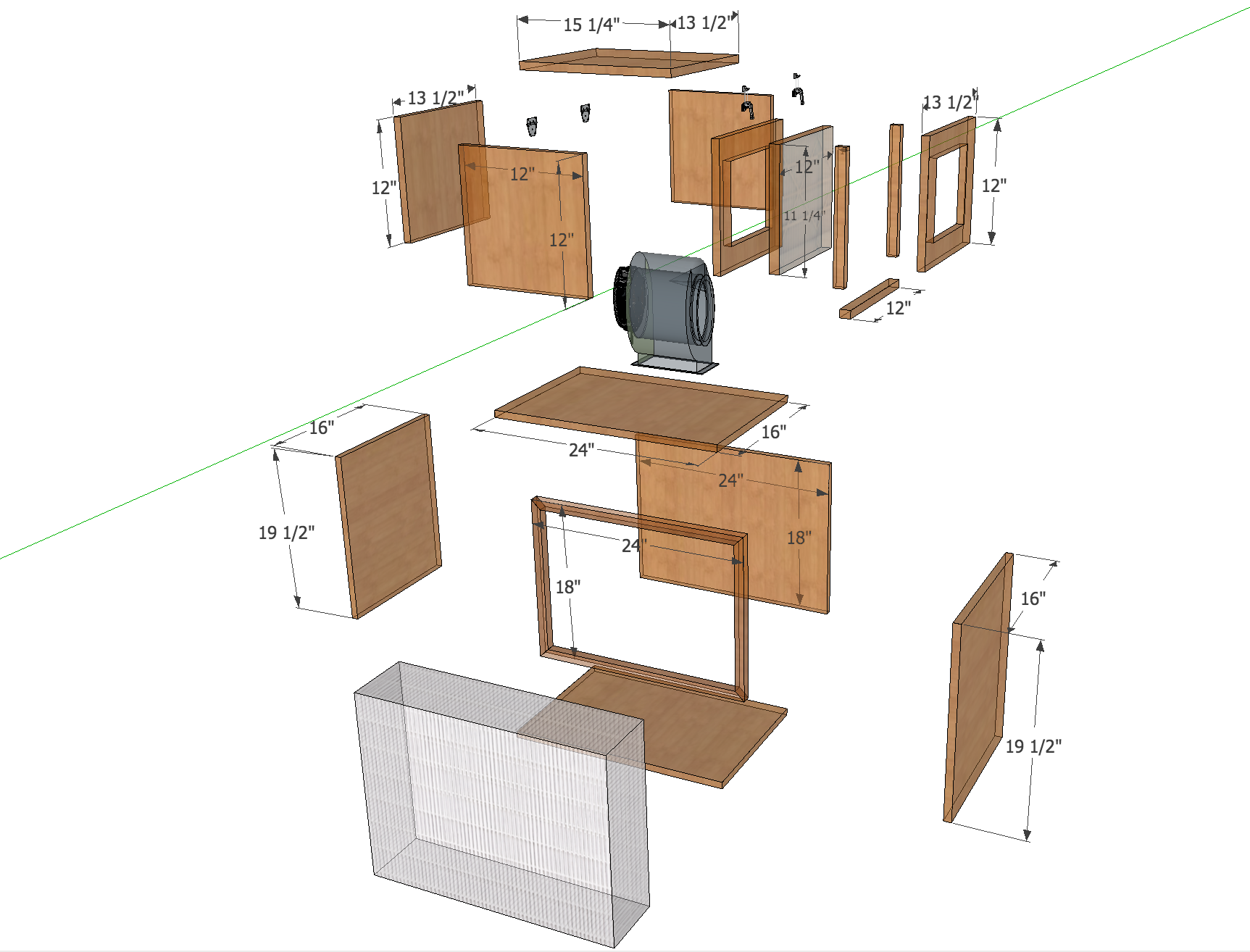

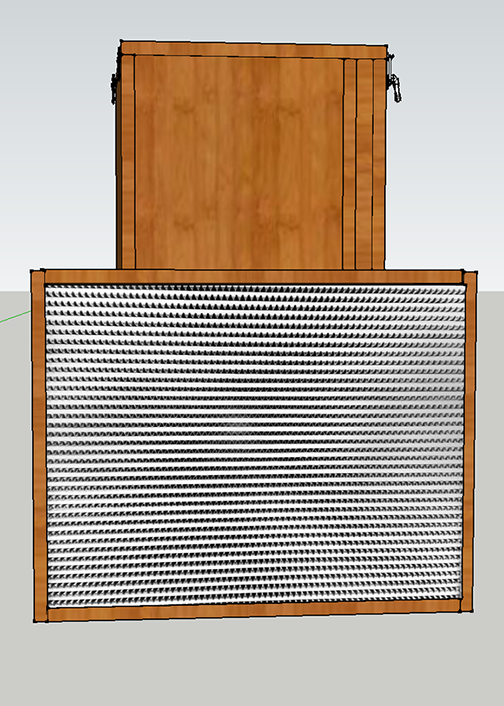


⚠️ Important Safety Warning ⚠️
Building this device involves working with mains electricity (120V). If you are not 100% confident in your ability to wire components safely, hire a licensed electrician to perform the electrical connections. Faulty wiring can lead to electrical shock, fire, or damage to the components.
Overview of the Project
This project involves building a Laminar Flow Hood (also called a Horizontal Flow Bench). It uses a high-powered blower (a "can fan") to push air through a High-Efficiency Particulate Air (HEPA) filter. The filter removes contaminants (mold spores, bacteria, dust) from the air, creating a sterile, laminar (smooth, non-turbulent) flow of clean air in which you can perform sterile mycology work.
Final Result: You will have a self-contained unit with a pre-filter, a powerful fan, a HEPA filter, and a sealed work box.
Parts & Materials List
(Based on the Shroomery post)
Fan/Blower: Dayton 1TDT2 Blower, 549 CFM, 115V, 2.05 Amp, 1640 RPM. This is the heart of the unit.
Filter: 12" x 24" x 12" HEPA Filter (99.99% efficient @ 0.3 µm). This is the most critical component for sterility.
Pre-Filter: A basic furnace filter (e.g., 12x24x1") to extend the life of the expensive HEPA filter by catching large dust particles.
Box Construction:
3/4" Plywood or MDF - A single 4' x 8' sheet will be more than enough.
1x2" or 1x3" Pine Boards - for bracing and framing.
Silicone Sealant (100% Silicone) - for creating an airtight seal.
Wood Glue, Screws (1.5" and 2.5"), Nails.
Electrical:
Standard Power Cord (lamp cord or computer power cable).
Wire Nuts or Wago Connectors.
Electrical Tape.
Other:
Aluminum Filter Tape (foil tape) - for sealing joints.
Paint or Polyurethane - to seal the wood inside and out, making it easy to clean and preventing mold growth on the wood itself.
Tools Required
Tape Measure & Pencil
Circular Saw or Table Saw (a circular saw and a straight-edge guide works perfectly)
Jigsaw (for cutting the fan hole)
Drill/Driver with assorted drill bits and screwdriver bits
Staple Gun (optional, for pre-filter)
Caulking Gun (for silicone)
Scissors (for filter tape)
Sandpaper (medium and fine grit)
Safety Gear: Glasses, gloves, hearing protection, dust mask.
Step-by-Step Build Instructions
Phase 1: Design & Planning
Understand the Airflow Path: Air enters through the pre-filter on the back/bottom, is sucked in by the fan, pressurized in the plenum (the sealed box behind the filter), and then forced evenly through the HEPA filter.
Finalize Dimensions: Your box's front face (where the HEPA filter mounts) is determined by the filter size: 12" tall x 24" wide. The depth is up to you, but 16-18 inches is a common and effective depth for the plenum.
Phase 2: Building the Box
Cut the Wood:
Sides (2 pieces): 12" tall x (your chosen depth, e.g., 18") long.
Top (1 piece): 24" wide x (your chosen depth, e.g., 18") long.
Bottom (1 piece): 24" wide x (your chosen depth, e.g., 18") long.
Back (1 piece): 12" tall x 24" wide. This piece will have a large hole cut in it for the fan.
Front Frame (2 pieces): Cut two rails from 1x2" or 1x3" wood to act as a ledge for the HEPA filter to sit on. They should be about 22-23" long to fit inside the box.
Cut the Fan Hole:
Find the center of the back panel. An 8" fan typically requires an ~7.75" hole, but always use the template provided with your specific fan or measure the fan's collar.
Use a jigsaw to carefully cut out the hole.
Assemble the Box:
Apply wood glue to the edges of your side panels.
Attach the top and bottom panels to the side panels using screws. Pre-drill your holes to prevent splitting.
Attach the back panel with the fan hole to the assembly. Do not fully seal this with silicone yet.
Create the Filter Ledges:
Inside the box, on the front opening, attach the two horizontal rails. One will be near the top and one near the bottom. The HEPA filter will sit on these ledges from the front.
Ensure they are level and secure. The filter should sit flush with or slightly recessed from the front of the box.
Phase 3: Installing the Fan & Sealing
Mount the Fan:
Place the 8" Can Fan over the hole on the outside of the back panel. The fan's intake should be pointing away from the box.
Mark and pre-drill the mounting holes.
Apply a thick bead of silicone sealant around the fan's collar where it will meet the wood.
Screw the fan firmly and securely to the back panel. Wipe away any excess silicone.
Seal the Box:
This is the most important step for performance. Every single seam, corner, and joint inside the box must be airtight.
Run a generous bead of silicone sealant along every interior seam. Smooth it with your finger or a tool.
Reinforce the exterior seams with aluminum foil tape.
Let the silicone cure completely as per the manufacturer's instructions (usually 24 hours).
Phase 4: Electrical Wiring
Wire the Speed Controller:
DISCONNECT EVERYTHING FROM POWER.
The router speed controller has an input (line in) and an output (load out).
Connect your power cord to the input terminals on the speed controller.
Connect the wires from the fan to the output terminals on the speed controller.
Follow the specific wiring diagram that came with your speed controller. Typically: Black (Hot) to Black, White (Neutral) to White, Green/Bare (Ground) to Green.
Secure all connections with wire nuts or Wago connectors and ensure everything is tucked safely into the controller's housing.
Phase 5: Finishing & Final Assembly
Paint/Seal the Wood:
Sand the entire box, inside and out.
Apply 2-3 coats of paint or polyurethane to all surfaces. This creates a smooth, cleanable, and non-porous surface that won't harbor contaminants. Let it dry thoroughly.
Install the Filters:
Pre-Filter: Place the 12x24x1" furnace filter over the fan intake on the back of the unit. You can secure it with a simple wooden frame held on with screws or even strong tape for easy replacement.
HEPA Filter: Place the heavy HEPA filter onto the interior ledges on the front of the box.
Seal the HEPA Filter: Apply foil tape all the way around the seam where the filter meets the wooden box. This creates the final, critical airtight seal. Do not use silicone here, as you will need to replace the filter eventually.
Phase 6: Testing
Power On Test:
Place the unit on a stable surface. Plug the speed controller into the wall.
Turn the dial on the speed controller to its lowest setting, then plug in the fan.
Slowly turn the dial up. You should feel a strong, even flow of air coming from the entire face of the HEPA filter.
Airflow Test (The "Smoke Test"):
Use a stick of incense or a smoke pen. Turn the unit on to its operational speed (usually 70-80% power on the dial).
Hold the smoke source about 6 inches in front of the filter and let the smoke rise naturally. The smoke should be blown away in a smooth, laminar flow without any turbulence or back-drafting. If the smoke is chaotic near the filter face, your plenum may be too small or the fan speed may be too high.
Usage Tips
Let the unit run for 20-30 minutes before use to purge any contaminants from the work area.
Always wipe down the work surface with 70% isopropyl alcohol before and after use.
Work in the "laminar flow" zone, which is typically within 6-10 inches of the filter face. Keep your open petri dishes, grain jars, and agar work in this clean airstream.
Replace the pre-filter regularly (every 3-6 months depending on use) to maintain airflow and protect the HEPA filter.
The HEPA filter itself should last for many years in a clean home environment.
Enjoy your new, professional-grade sterile workbench!
September Mushroom of the Month: Stalked Puffball-in-Aspic, Calostoma cinnabarinum
The September Mushroom of the Month is the Stalked Puffball-in-Aspic, Calostoma cinnabarinum





🍄⭐The September mushroom of the month is the Stalked Puffball-in-Aspic, Calostoma cinnabarinum
👏 Congrats to Hannah for guessing it right and winning a membership to the society! 🎉
You can also be a supporting member to stay dialed-in with events & discover next month’s mystery mushroom.
Not quite a puffball
Stalked Puffball-in-Aspic may sound like a puffball, but it isn’t. Long mistaken for a puffball, earthstar, or stinkhorn, Calostoma cinnabarinum is now classified in the order Boletales, despite little resemblance to its relatives. Its name “cinnabarinum” comes from the Greek kinnábari, for its vivid cinnabar-red color, like dragon’s blood. Common names include red slimy-stalked puffball, aspic puffball, gelatinous-stalked puffball, and “hot lips.” In central Mexico, it’s called “orchid fungus” in Spanish (hongo orquídea) and Nahuatl (huang noono).
A fungi defined by its slime
A key trait of this mushroom is its “aspic”, a gelatinous veil that surrounds the young fruit before sloughing off. The goo has been compared to amphibian eggs or “small red tomatoes in jelly.” As it matures, a whitish stalk emerges while the red tip elongates and fades. Mycorrhizal with oaks, it grows alone or in groups, often in moss beds or wet lowlands, from spring through fall. Its range includes eastern North America, Texas, possibly the Southwest, as well as Central and South America, with reports from Asia. It’s especially common at higher elevations; the described collections are from North Carolina.
Can you eat it?
Few would be tempted to eat this mushroom, and most field guides list it as inedible. Yet a study of mestizo descendants of the Otomi people in Tenango de Doria, Mexico, found that immature specimens, called yemitas, were once eaten raw—especially by children—though this is no longer common. The gleba is described as mild in taste, not sweet despite local recollections. A 1986 ethnomycological study in Veracruz recorded its use to treat gastrointestinal distress. Still, other folk beliefs warn it is poisonous, citing its bright color as a sign of danger.
